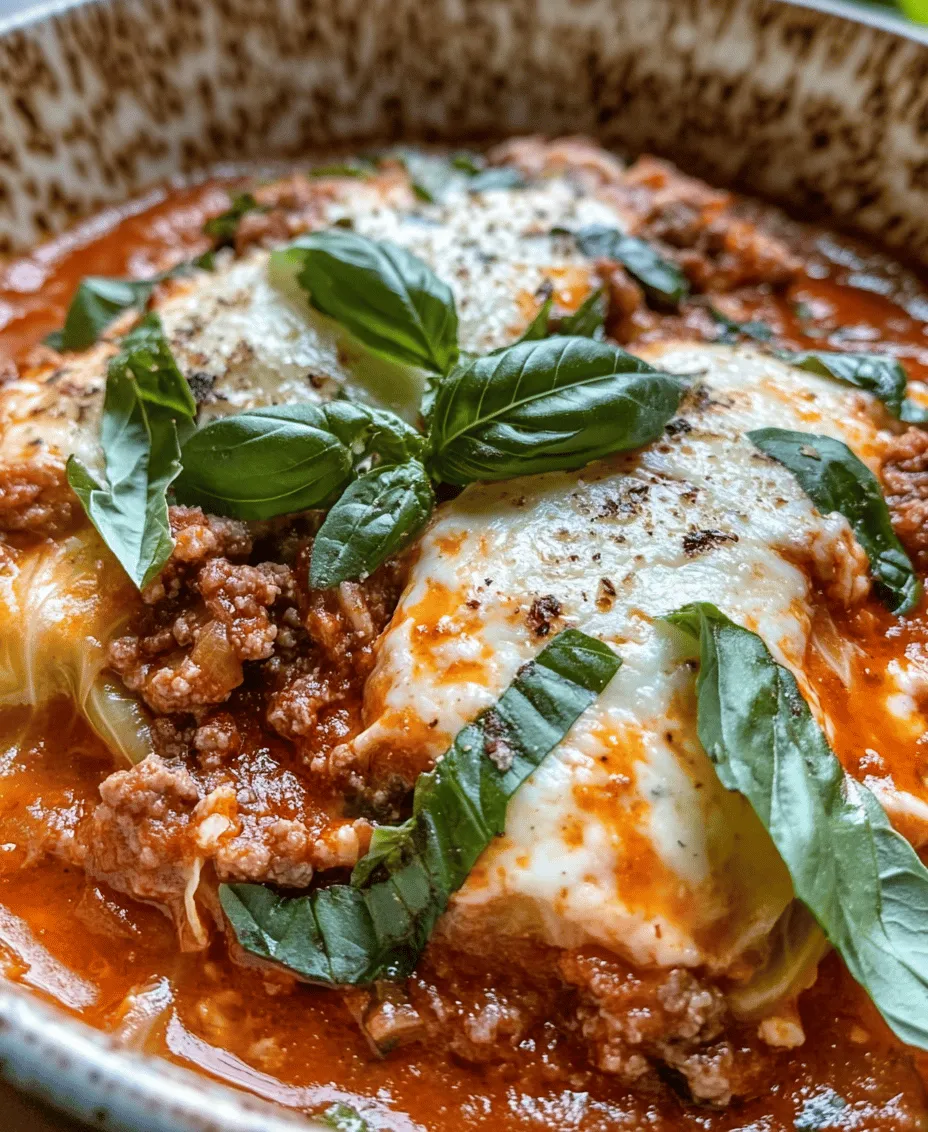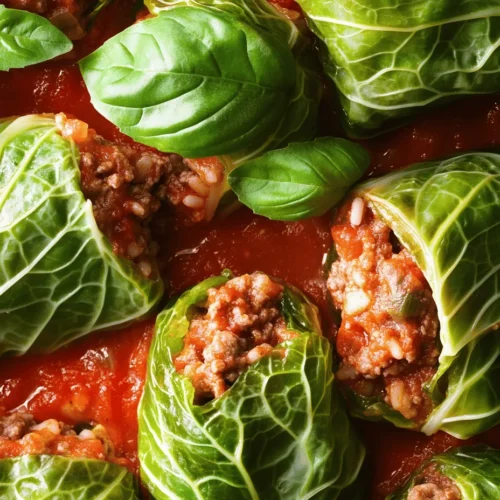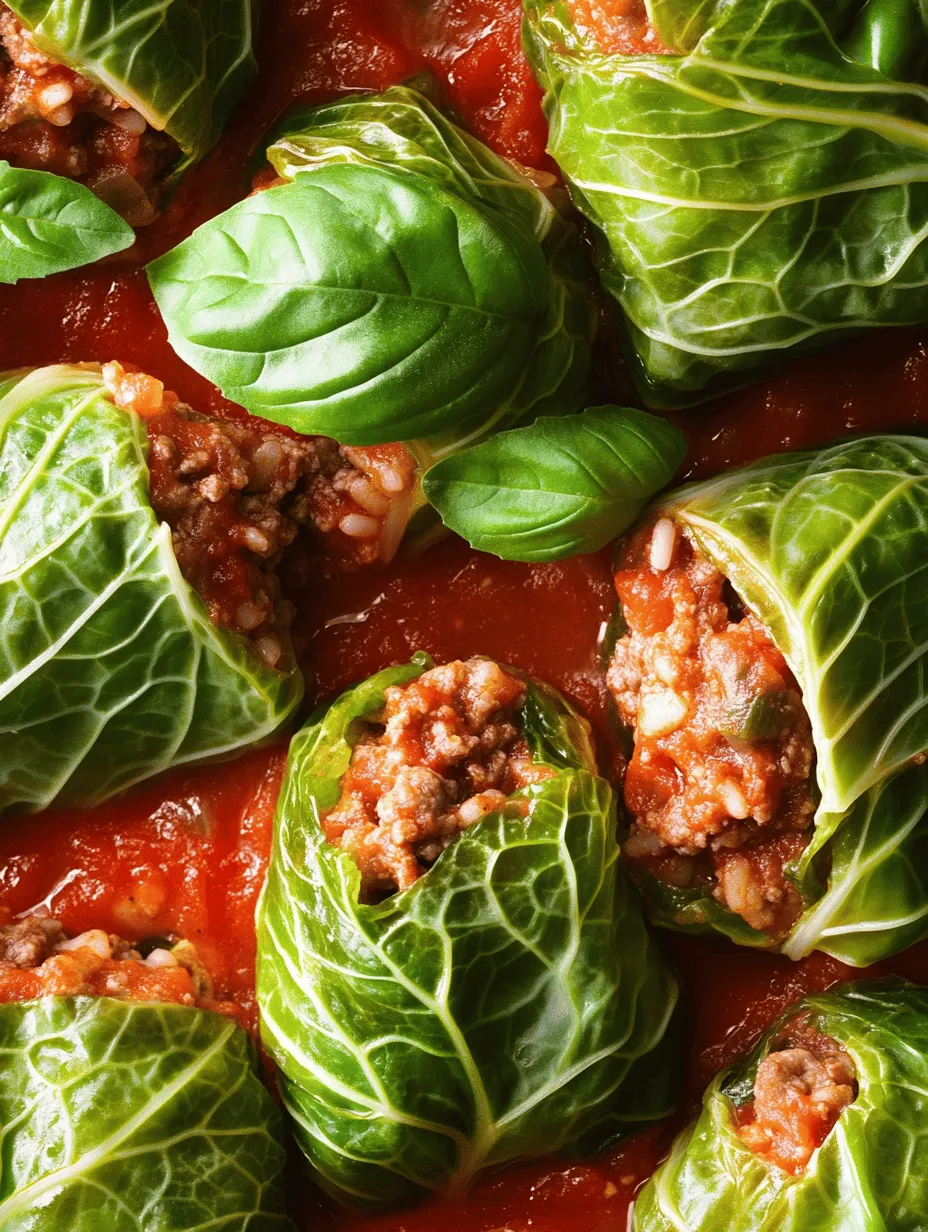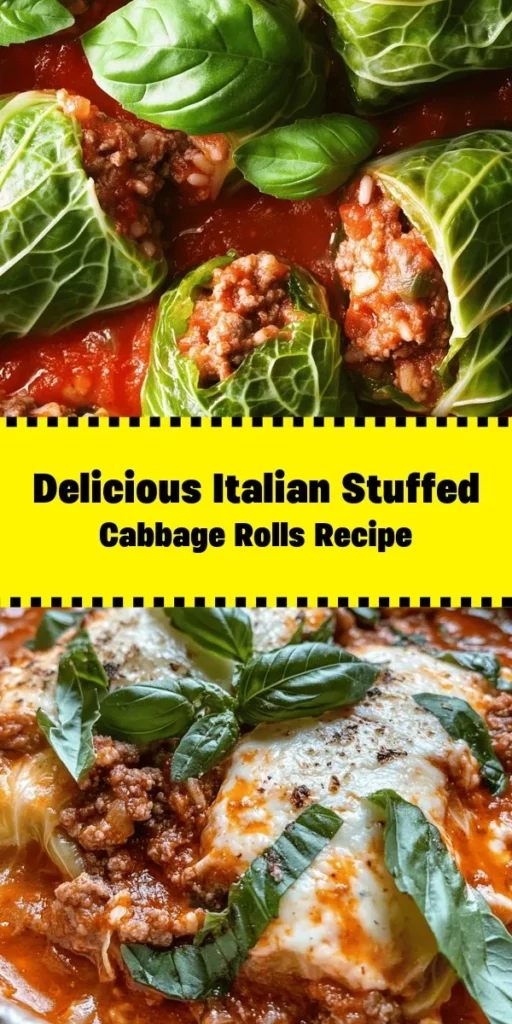Introduction
Italian stuffed cabbage rolls, or “involtini di cavolo,” are more than just a meal; they are a beloved tradition that evokes warmth and comfort. With their origins deeply rooted in the heart of Italy, these delightful rolls are a staple in many Italian households, often served during family gatherings or festive occasions. The combination of tender cabbage leaves enveloping a savory filling creates a dish that is both hearty and satisfying, making it a favorite among those who enjoy the rich flavors of Italian cuisine.
As you delve into the world of stuffed cabbage rolls, you’ll discover not only their mouthwatering taste but also their versatility. This recipe allows for various adaptations, catering to different dietary needs and preferences. Whether you prefer a meat-filled version or a vegetarian alternative, these rolls can be tailored to suit your palate while still delivering that authentic Italian experience.
The comforting nature of stuffed cabbage rolls makes them perfect for cozy weeknight dinners or special gatherings with loved ones. Each roll is a labor of love, showcasing the care and attention that goes into preparing a meal that brings people together. In this article, we will explore the unique ingredients that make this dish stand out, as well as the preparation steps that will lead you to a delicious outcome.
Understanding the Ingredients
To create authentic Italian stuffed cabbage rolls, it is essential to understand the key ingredients that contribute to their unique flavor and texture. Each component plays a vital role in the overall success of the dish, and knowing how to select and prepare these ingredients will elevate your culinary experience.
Cabbage: The Foundation
At the heart of stuffed cabbage rolls lies the humble cabbage. Typically, green cabbage is the preferred choice due to its tender leaves that are ideal for wrapping the filling. Cabbage is not only a versatile vegetable but also a nutritional powerhouse. It is low in calories and high in vitamins C and K, as well as fiber, making it a healthy addition to any meal.
When selecting cabbage for your rolls, look for heads that are firm, heavy for their size, and free from blemishes. The leaves should be tightly packed, indicating freshness. If possible, opt for organic cabbage to ensure you are consuming a product that is free from harmful pesticides.
To prepare the cabbage for stuffing, blanching is necessary. This process softens the leaves, making them pliable and easier to work with. It also enhances the vibrant color and flavor of the cabbage, ensuring that your rolls are as visually appealing as they are delicious.
Meat Choices: Ground Beef vs. Ground Turkey
The filling is where the flavor truly shines, and selecting the right meat is crucial. Ground beef is a classic choice for stuffed cabbage rolls, offering a rich and hearty flavor that pairs beautifully with the other ingredients. It has a higher fat content, which adds moisture and a robust taste to the filling. However, if you are looking for a leaner option, ground turkey is an excellent alternative. It provides a lighter taste and texture while still retaining the essence of the dish.
When deciding between ground beef and ground turkey, consider the health implications as well. Ground turkey is often lower in calories and saturated fat compared to ground beef, making it a popular choice for those seeking a healthier lifestyle. Whichever option you choose, be sure to season your meat well to enhance the overall flavor of the rolls.
The Perfect Rice: Arborio vs. Jasmine
Rice is another essential ingredient in stuffed cabbage rolls, serving as a binding agent that helps hold the filling together. The choice of rice can significantly impact the dish’s texture and flavor. Arborio rice, a short-grain variety traditionally used in risottos, is a fantastic option due to its creamy consistency when cooked. This rice absorbs flavors beautifully, adding richness to the filling.
On the other hand, jasmine rice is known for its aromatic qualities and fluffy texture. It has a slightly nutty flavor that can complement the savory profile of the rolls. While both types of rice can work well in this recipe, consider your personal preference and the flavor profile you wish to achieve.
Cheese Selection: Mozzarella and Parmesan
Cheese plays a crucial role in enhancing the flavor and texture of stuffed cabbage rolls. Mozzarella is often used for its melting properties and mild flavor, which adds a creamy element that binds the filling together. Fresh mozzarella can provide a delightful stretchiness, while shredded mozzarella offers convenience and ease of use.
Parmesan cheese, on the other hand, brings a sharp and nutty flavor that elevates the overall taste of the dish. Grated or shaved, Parmesan can be sprinkled both inside the filling and on top of the rolls before baking, creating a delicious crust that adds depth to each bite. When selecting cheese, aim for high-quality options to ensure the best flavor possible.
Herbs and Seasonings: Elevating the Flavor Profile
The key to creating a memorable stuffed cabbage roll lies in the herbs and seasonings used. Dried oregano, basil, and red pepper flakes are commonly employed to build a complex flavor profile that will tantalize your taste buds.
Oregano is a staple in Italian cooking, known for its earthy and slightly peppery flavor. It pairs perfectly with the savory elements of the meat and rice filling. Basil adds a touch of sweetness and freshness, brightening up the overall taste. Red pepper flakes introduce a subtle heat, allowing you to customize the spice level according to your preference.
In addition to their flavor-enhancing properties, these herbs also boast various health benefits. Oregano, for instance, contains antioxidants and has anti-inflammatory properties, while basil is rich in vitamins A and K. By incorporating these herbs into your stuffed cabbage rolls, you not only improve the taste but also add nutritional value to your meal.
Preparation Steps
Now that you have a better understanding of the ingredients that make up Italian stuffed cabbage rolls, it’s time to dive into the preparation steps. This comprehensive guide will walk you through the process, ensuring that you achieve the perfect rolls every time.
Blanching the Cabbage
The first step in preparing your stuffed cabbage rolls is blanching the cabbage. This technique softens the leaves, allowing them to be easily wrapped around the filling without tearing. Here’s how to do it:
1. Boil Water: Fill a large pot with water and bring it to a rolling boil. Ensure there is enough water to fully submerge the cabbage head.
2. Prepare the Cabbage: While the water is heating, remove any damaged outer leaves from the cabbage. Rinse the head under cold water to remove any dirt or impurities.
3. Blanch the Cabbage: Carefully place the whole cabbage head into the boiling water. Allow it to cook for about 2-3 minutes. You’ll notice the outer leaves start to soften and change color.
4. Remove and Cool: Using tongs, carefully remove the cabbage from the boiling water and place it in a bowl of ice water. This step stops the cooking process and helps preserve the vibrant green color.
5. Separate the Leaves: Once the cabbage is cool enough to handle, gently peel away the outer leaves. You’ll need about 12-15 leaves for stuffing. If the inner leaves are still too firm, you can blanch them in the boiling water for an additional minute.
6. Trim the Leaves: To make wrapping easier, trim the thick vein of each cabbage leaf with a knife. This will help the leaves bend without breaking.
Once you have your cabbage leaves prepared, you’re ready to move on to creating the flavorful filling that will go inside. Stay tuned for the next part, where we will delve into creating the delicious mixture that makes these rolls irresistible.

Blanching the Cabbage Leaves
Blanching is a crucial step in the preparation of Italian stuffed cabbage rolls, as it ensures the cabbage leaves become pliable enough for rolling. To blanch your cabbage, start by bringing a large pot of salted water to a rolling boil. Carefully remove the core from the cabbage head and place it in the boiling water. Allow it to cook for about 2-3 minutes, or until the outer leaves turn bright green and soften.
Using tongs, gently peel away the softened leaves and place them in a bowl of ice water to halt the cooking process. This method not only preserves the vibrant green color but also keeps the leaves crisp. Continue this process until you have about 12-14 leaves, which should be enough for your stuffing. This blanching technique is vital; it prevents the leaves from tearing during assembly and ensures they are tender, making your rolls easy to eat.
Creating the Filling
With your cabbage leaves ready, it’s time to prepare the filling. In a large mixing bowl, combine cooked rice, ground meat (such as beef, pork, or a combination), finely chopped onions, minced garlic, and herbs such as parsley and basil. The key to achieving the right consistency is to balance moisture and texture. If you find the mixture too dry, add a splash of chicken or vegetable broth. Conversely, if it feels overly wet, incorporate a bit more rice or breadcrumbs to absorb excess moisture.
Season the mixture generously with salt, pepper, and a pinch of red pepper flakes for a hint of heat. Taste the filling before stuffing; this step is essential as it allows you to adjust the seasoning to your preference. Remember, the flavors will meld during cooking, so aim for a well-seasoned filling that excites your palate.
Assembling the Rolls
Now comes the fun part: assembling the stuffed cabbage rolls. Lay a blanched cabbage leaf flat on a clean work surface. Place a generous spoonful of filling at the base of the leaf, ensuring not to overfill, as this can lead to bursting during cooking. Fold the sides of the leaf over the filling, then roll it tightly from the base to the top, securing the filling inside. Repeat this process until you have assembled all your rolls.
To keep your rolls secure, consider using a toothpick or kitchen twine to hold them together if needed. This technique is especially useful if you are using larger leaves, which can sometimes unfold during cooking. As you assemble, place the rolls seam-side down in a baking dish, which will help them maintain their shape during baking.
Baking the Rolls
Once all the rolls are assembled, it’s time to bake them to perfection. Start by preheating your oven to 350°F (175°C). Spread a thin layer of marinara or tomato sauce on the bottom of a large baking dish to prevent sticking and add flavor. Arrange the cabbage rolls in the dish in a single layer, then pour more sauce over the top, ensuring they are well-coated. This layering not only enhances the flavor but also keeps the rolls moist during baking.
Cover the dish tightly with aluminum foil to trap steam, which is essential for cooking the rolls evenly and preventing them from drying out. Bake for about 45 minutes to an hour, or until the meat is cooked through and the flavors have melded beautifully. For a delightful finish, remove the foil in the last 10-15 minutes of cooking to allow the top to brown slightly and the sauce to bubble.
Serving Suggestions
When it comes to serving your Italian stuffed cabbage rolls, presentation is key. Use a large serving platter, and carefully arrange the rolls in a spiral or circular pattern for an inviting display. Drizzle additional marinara sauce over the top and garnish with freshly chopped parsley or grated Parmesan cheese for added color and flavor.
Pair your cabbage rolls with a side of crusty Italian bread to soak up the delicious sauce or a light salad dressed with a tangy vinaigrette for a refreshing contrast. A glass of Chianti or a light-bodied red wine would complement the flavors beautifully, enhancing the overall dining experience.
Nutritional Benefits of Stuffed Cabbage Rolls
Italian stuffed cabbage rolls are not only delicious but also packed with nutritional benefits. Cabbage is a low-calorie vegetable that is rich in vitamins C and K, providing antioxidants that promote overall health. The combination of meat and rice delivers a good source of protein, essential for muscle repair and growth.
Adding vegetables like onions and garlic increases the fiber content, aiding digestion and promoting satiety. Furthermore, using whole grains, such as brown rice, can enhance the nutritional profile by adding complex carbohydrates and additional fiber. Overall, these rolls can be a wholesome meal option that supports a balanced diet.
Cultural Significance of Cabbage Rolls in Italian Cuisine
Cabbage rolls hold a special place in Italian culinary traditions, particularly within family gatherings and festive occasions. Originating from Eastern European cuisine, they have been embraced by Italian families, often made with regional twists that reflect local ingredients and cooking styles.
In Italy, variations of cabbage rolls can be found, such as using different meats, grains, or sauces, depending on the region. For instance, in Southern Italy, you might find versions that incorporate spicy sausage or local vegetables. Cabbage rolls are often associated with comfort and family bonding, as generations come together to prepare and share this hearty dish around the dinner table.
Variations and Customizations
One of the wonderful aspects of stuffed cabbage rolls is their versatility. For those looking to adapt the recipe to their dietary preferences, there are numerous variations to explore. For a vegetarian option, consider using lentils or quinoa as the base of your filling, combined with finely chopped vegetables and herbs. This provides a satisfying texture while remaining meat-free.
If you prefer a spicier dish, add diced jalapeños or a sprinkle of cayenne pepper to the filling. For a unique flavor profile, experiment with different herbs, such as dill or oregano, which can add depth to the dish. Additionally, feel free to swap out the traditional marinara sauce for a creamy sauce or a spicy salsa for a fresh take on the classic recipe.
Storing and Reheating Leftovers
Storing leftover stuffed cabbage rolls is simple and ensures that you can enjoy them again later. Allow the rolls to cool completely before transferring them to an airtight container. They can be stored in the refrigerator for up to 3-4 days or frozen for up to three months. If freezing, ensure you layer them with parchment paper to prevent sticking.
When it comes to reheating, you can either place them in the oven at 350°F (175°C) until heated through, or for a quicker option, use the microwave. To maintain their moisture, cover the rolls with a damp paper towel while microwaving. This will help prevent them from drying out, allowing you to enjoy the flavors just as deliciously as when they were first made.
Conclusion
Italian stuffed cabbage rolls are not just a meal; they are an experience that brings families together, celebrating the rich flavors and traditions of Italian cuisine. This dish serves as a comforting reminder of the joy found in cooking and sharing food with loved ones. As you explore this recipe, you’ll not only be creating a delicious meal but also connecting with the cultural significance behind it.
Encourage your family and friends to gather around the table and enjoy these hearty rolls, creating memories that will last a lifetime. So, roll up your sleeves, gather your ingredients, and dive into the delight of making your Italian stuffed cabbage rolls. You’ll find that this beloved comfort food is well worth the effort, inviting warmth and joy into your home.



